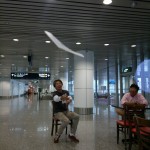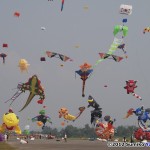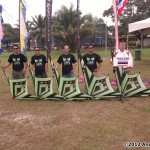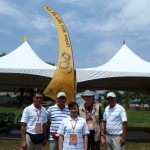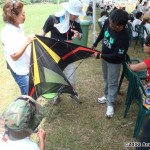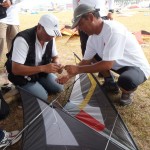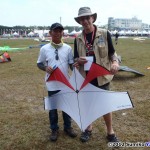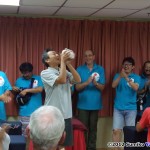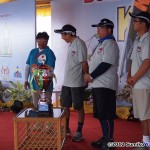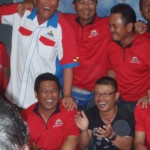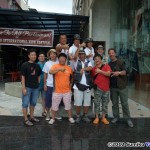HOT TEAM FLYING IN BINTULU
From September onward, judging SportKite competitions in Europe usually means wearing something to keep out the wind and rain, thick socks and as many thermal base layers as you can cram on while retaining the ability to walk. So you can imagine my bewilderment at the idea of judging a late season competition in temperatures of around 35ºC. That’s hotter than the hottest summers’ day here in UK. Would I wilt in those temperatures? Would my brain fry? How would I cope with the hot-house humidity and not only that . . . I had nothing to wear! My daughter told me “Don’t worry, Dad . . . think of it as a new wardrobe opportunity and drink plenty of water when you get there”.
At Kuala Lumpur Airport, I met up with the delegation from AJSKA who were also heading for Bintulu. I was struggling to remember my few words of Japanese but, thankfully, ace interpreter Gary Ikebe was with the AJSKA party and made it very easy for me to renew friendships with folks I’d not seen since the Tokyo Bay Flight Party in 2008. In no time we had a selection of iFlites floating gracefully around the high ceiling airport lounge.
The air-conditioned comfort of Kuala Lumpur Airport followed by a short hop on a 737 did little to prepare me for the shock of landing at Bintulu. The skies were deceptively cloudy but the early afternoon temperature felt like stepping into a sauna. The welcome from the Bintulu Kiteflyers who had come to pick us up from the airport was equally warm and they quickly had our kite bags and luggage loaded onto a truck and put us onto a delightfully cool bus for the short run into Bintulu town The hotel was air conditioned and comfortable but, after a quick shower, I decided that I needed to get out and get acclimatised as quickly as possible.
Bintulu is a fascinating place, in some parts very modern with big shopping malls and familiar stores and in other parts more traditional . . . a large and thriving street market, roadside food-sellers, narrow independent shops with aisles stacked to the ceiling with everything you could possibly wish to buy and shaded outdoor bars offering refreshing drinks. The local language is Malay but most people seemed to understand English well enough and there was no problem with communication. People in the streets easily recognised me as not being a local, but there were lots of smiles, enquiries of “Layang layang?” (the Malay word for Kites) followed by impromptu greetings “Welcome to Bintulu”. I felt very welcome and safe.
On the following morning most folks went off to the flying field, a huge area of grass and tarmac that had originally been the town’s airport, just a few minutes’ walk from the hotel. I stayed with the AJSKA delegation to meet with Mr Ansari (Ansari), the organising Secretary of the Bintulu International Kite Festival, and the genial Sia Jau Ren (Sia-San) of the Bintulu Kite Club. AJSKA Chairman Seiji Kato (Kato-San) and Gary Ikebe had traveled to Bintulu earlier in the year to meet Ansari and Sia-San. Together they had agreed that the 8th Borneo International Kite Festival would host, as part of the event, the 1st Asia Pacific Sport Kite Teams Championship. Kato-San, an old friend and colleague from WSKC 2008, would be Chief Judge, assisted by Mr Nash from Singapore, by members of 2008 World Champion Team Air Rex and fellow WSKC contenders Team Ninja and myself. Eight teams from the Asia Pacific region, representing Malaysia (3), China (2), Japan, Singapore and Thailand would be taking part.
The initial enquiry implied that if this competition were a success, the Organisers would consider inviting more teams from Europe and North and South America in 2013! The presence of WSKC President, David Gomberg and Organiser, Gerard Clement showed that they were also seriously interested in this possibility and were keen to support the Bintulu organisers in bringing their ambition to reality.
The competition was flown to IRBC rules but, in recognition of the relative inexperience of some of the teams, it was decided to dispense with the need for a technical precision routine. The competition would be flown over two days with figures in the pre-lunch period each day and ballets in the afternoons.
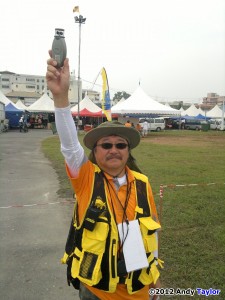 Keizo Yamazaki of Japan served throughout as field director, ably assisted by Gary Ikebe, translating back and forth in English and Japanese whenever necessary. This unique double-act worked without a single hitch. Pair Karasu stood in as line judges while those members of Air Rex, Ninja and who were not required on the field as judges worked tirelessly as pit bosses and additional ground crew. The whole process was carried out seamlessly, with co-operation and good humour all round. At the later debrief I was happy to tell the teams their conduct in getting themselves on and off the field and helping each other had been well up to standard that I would expect to see at WSKC.
Keizo Yamazaki of Japan served throughout as field director, ably assisted by Gary Ikebe, translating back and forth in English and Japanese whenever necessary. This unique double-act worked without a single hitch. Pair Karasu stood in as line judges while those members of Air Rex, Ninja and who were not required on the field as judges worked tirelessly as pit bosses and additional ground crew. The whole process was carried out seamlessly, with co-operation and good humour all round. At the later debrief I was happy to tell the teams their conduct in getting themselves on and off the field and helping each other had been well up to standard that I would expect to see at WSKC.
The contest itself proved to be very interesting. For all of the teams, this was their first taste of international competition and some of them had only been flying together for a matter of months. At the end of the first round of figures the judges were pleased to find that scores were about the same as they would expect from novice competitors anywhere in the world. Let no-one pretend that Team compulsory figures are easy so the achievement of flying coherent and recognisable figures was very much applauded by all the judges.
The Ballets proved to be where the teams had invested their practice time, though what we saw varied from team to team. Some were clearly competent flyers but ran short of choreographic ideas. Others teams had spent time putting their routines together but lost marks through untidy execution. But what pleased the judges was that every one of the teams had put together credible, coherent ballets; not an easy feat for teams without a wealth of competition experience behind them. The judges were also pleased to note the surprising maturity with which teams recovered quickly from any problems they encountered and the quick and appropriate response of ground crews whenever help was needed.
At the debrief following the second days flying, Chief Judge Kato-San and I were happy to confirm that we had judged the contest by the same criteria that we would apply to any competition, anywhere in the world. The scores the competing teams had achieved in Bintulu reflected the work they would need to do to bring themselves up to the standard of the best teams from Europe, Japan, USA and South America. The teams understood that the standard of competition at WSKC is very high, though we were able to tell them that their scores revealed they were closer to the pace than they had perhaps thought. With the next scheduled WSKC coming up in 2014 there was plenty of time to raise their game and we hoped that the experience of competing at Bintulu would help them on that quest.
In what turned out to be a very close competition, the spread of marks was much tighter than we might have expected. Particular mention is due to the teams who finally graced the podium. Team Kung Fu (3rd) from China showed a good understanding of the figures and had clearly been well drilled by team leader Ming Ming. Local Team Silat (2nd) from the Bintulu Kite Club showed some very mature and exciting choreography within their capably executed ballet, but the most consistent all-rounders were Japan’s Team SSKC who delivered tight, well synchronised performances that were good value for the very respectable scores which put them comfortably into first place overall.
For me, however, the best bits happened on the field outside the competition arena, seeing teams working together to help each other despite the barriers of language . . . seeing every one of the teams contributing energetically and with enthusiasm to the Festival display program . . . seeing the sheer investment of work and commitment put in by the AJSKA delegation, passing on a whole wealth of Sport Kite knowledge on everything from understanding the rules, making stick-practice more effective, adjusting bridles, tuning kites, sharing their wealth of expertise but always wearing it lightly. This was well appreciated by all the competitors and you could start to see it reflected in their demonstration performances.
I look forward to the next edition. Meanwhile, (with deepest apologies to Bob Seger’s “Katmandu”*) I can’t quite stop singing . . .
Won’t you take me back to Bintulu,
I really liked it there and so will you
If I ever get out of here,
That’s what I want to do.
I only went there as a one-week guest,
The folks out there all give their very best
So if I’m spared until next year,
I’m going to Bintulu!
Andy Taylor


